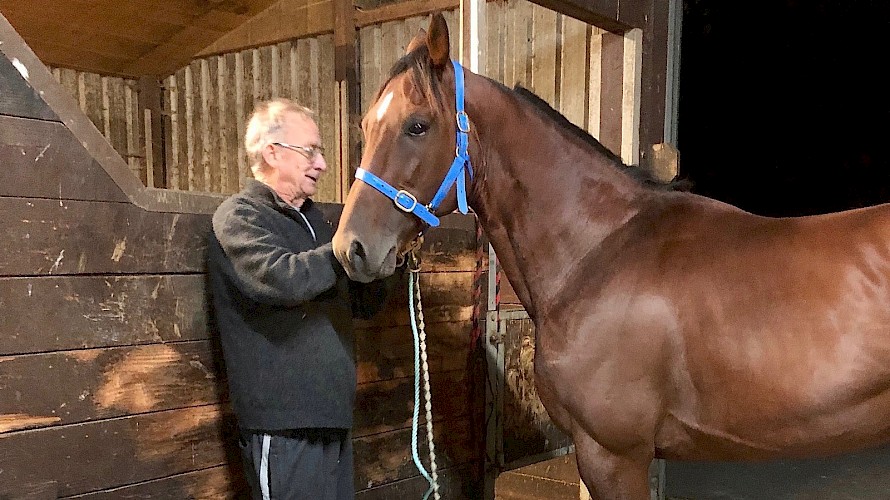
Trainer Ray Green attends to Copy That tonight after his delayed flight home from Melbourne.
Ray welcomes back the champ and we dispel the myths of EIPH and find testing anomolies
At the age of 77, trainer Ray Green is long past worrying about what the conspiracy theorists or uneducated animal rights activists think.
And when Copy That arrived back at Lincoln Farms just after 9pm this evening, Green was there to welcome the champ, despite another recent spell of illness that forced him to return to hospital, badly dehydrated, earlier in the week.
While Green is still battling to recover from a near fatal kick in the stomach, and subsequent surgery, his star pacer is fit as a fiddle, none the worse for his unscripted DNF in last weekend’s Hunter Cup in Melbourne.
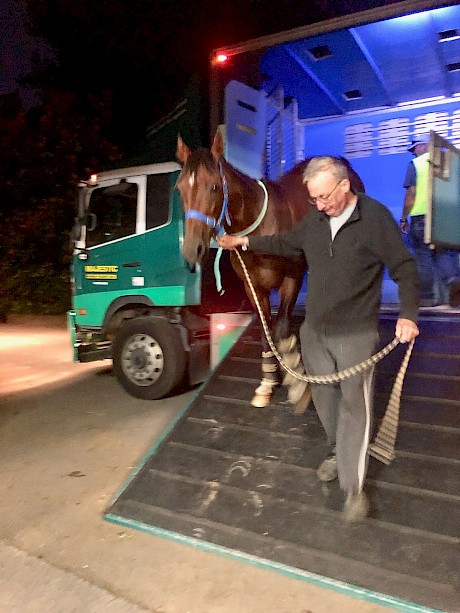 Ray Green unloads Copy That from the float just after 9pm tonight.That’s no surprise to Green, nor stable foreman Andrew Drake, who was in charge of Copy That on his Victorian campaign, and reported his quick recovery after the feature race at Melton on Saturday night.
Ray Green unloads Copy That from the float just after 9pm tonight.That’s no surprise to Green, nor stable foreman Andrew Drake, who was in charge of Copy That on his Victorian campaign, and reported his quick recovery after the feature race at Melton on Saturday night.
Listen to the trolls on Facebook and they’ll have you believe that something sinister was afoot when Copy That choked down and was pulled up inside the last lap. And the fact Harness Racing Victoria stewards reported he had a Grade 3 bleed was enough to stir others into saying he should be retired. How could his owners be so cruel to keep racing him?
The conspiracy theorists rely on the fact that both times Copy That has bled it has been in feature races in Australia.
The reality is Victoria is the only state actively scoping horses who perform badly and standing down horses even if they don’t bleed out the nose.
New South Wales Harness Racing regulatory veterinarian Martin Wainscott confirmed Copy That would not have been stood down for 28 days had the Hunter Cup been run at Menangle and there would have been no penalty in any other Australian state or in New Zealand. We would have been none the wiser about the bleed.
Strangely, Victoria’s protocols on exercise induced pulmonary haemorrhage (EIPH) differ from the Australian harness rules spelled out on its website.
Wainscott said Harness Racing NSW followed the national rule that only the appearance of blood at both nostrils constituted a bleeding attack. Horses are banned from racing for three months after a first bleed and for life after a second.
An amendment states horses who bleed from only one nostril have only to trial to the satisfaction of stewards before racing again.
Copy That did not show blood at the nose last Saturday, and neither did the other six horses who were scoped the same night, one reported to be Grade 3, two at Grade 2, one at Grade 1 and one at Grade 0.
Harness Racing Victoria maintains its very pro-active testing regime is “to ensure the safety and welfare of horses and drivers and to ensure horses’ performances are as consistent as possible as EIPH can adversely affect performance.”
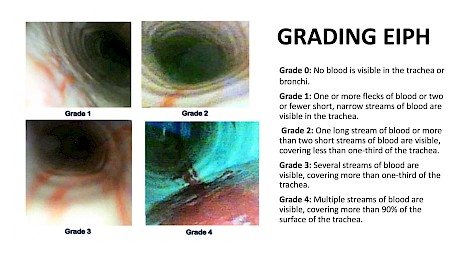 What the endoscope finds in the horse’s airway with varying grades of bleed.Impossible to predict
What the endoscope finds in the horse’s airway with varying grades of bleed.Impossible to predict
The undisputed scientific fact, however, is that it is impossible to predict EIPH levels in horses and its effects.
Researchers have found that the score of one EIPH episode isn’t necessarily predictive of the next.
In talking about the “vagaries of EIPH” at the 2021 American Association of Equine Practioners’ Convention in Tennessee, Professor Warwick Bayly said a horse who had a Grade 3 bleed one week could be a 0 the next time it was tested. A Grade 0 one week might be a Grade 2 the next start.
It follows Copy That could have tested at Grade 3 at any of his previous starts, including the Ballarat Cup, or in any of his spectacular winning runs here, including the New Zealand Cup.
One particularly finding in a recent publication of the Equine Veterinary Journal could, however, explain why Copy That’s bleed last Saturday night was one grade higher at three than when he was last reported to have bled after sitting parked in the Smoken Up Sprint at Melton last October.
The study found horses with moderate to severe EIPH (grades 3 or 4) raced faster over the early and mid-sections of their race than horses without EIPH.
“It is possible that these horses reach the breaking threshold of the small lung blood vessels at an earlier stage in the race compared to horses that start the race slower, compounding the severity thereafter,” it said.
“A study of barrel racing horses reported that horses with the most severe grade of EIPH were faster than horses without EIPH, a finding which may also reflect this rapid acceleration increasing the risk.”
The early pace in last Saturday night’s Hunter Cup was unprecedented, after Mach Dan came out like a rocket, putting half a length on pole runner Spirit Of St Louis, but was unable to cross when his driver Jack Callaghan kicked up.
Copy That’s driver Blair Orange attacked the leader hard after that, setting up an 80.3 lead time, five seconds faster than champion King Of Swing ran in winning the previous year.
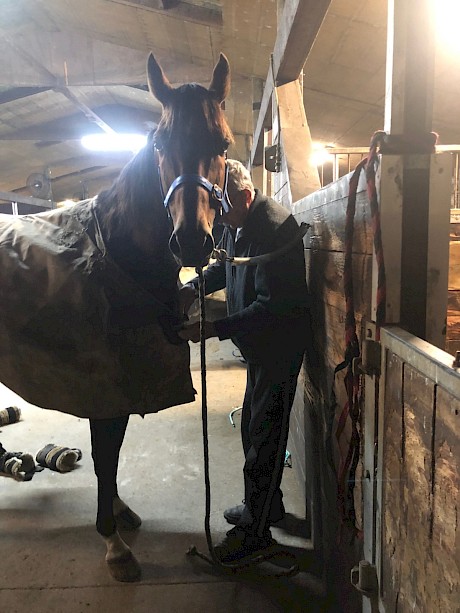 Back in familiar surroundings tonight at Lincoln Farms.Common
Back in familiar surroundings tonight at Lincoln Farms.Common
Uninformed protesters might be fuelled by reported bleeds but EIPH is common in all high-performance horses, with 65% of racehorses diagnosed through visual examination of the airways and 95% diagnosed after bronchoalveolar lavage (lung wash). Only 5% of bleeders lose blood out of their nose.
And, while the phenomenon also occurs in quarter horses, showjumpers, three-day eventers, barrel racers, steeplechasers, polo horses, racing camels and greyhounds, it is not just confined to racing animals.
Since first being reported in marathon runners in 1979, it has been found in healthy human athletes like triathletes, cyclists and swimmers, despite human blood pressure being much lower than horses.
Cause
The precise cause of EIPH has yet to be fully determined, but a well-accepted theory is that fragile lung blood vessels rupture in response to the extremely high blood pressure and low airway pressure experienced during strenuous exercise.
The barrier that separates the airway from the blood capillaries is ultra-thin to facilitate the efficient exchange of gases, but this predisposes them to breakage.
Ironically, as Professor Bayly described at the 2021 convention in Tennessee, “the physiologic factors that enable horses to be such wonderful athletes are also at the heart of EIPH.”
The horse’s spleen stores red blood cells and, during exercise, contracts to release red blood cells into the circulation and increase the horse’s oxygen transportation capacity.
Splenic contraction can increase horses’ resting red cell volumes by 40% to 50% during exercise. As a result of the increased blood volume, the heart rate jumps five or six-fold. Inevitably, the pressure increases and, after a while you get back pressure.
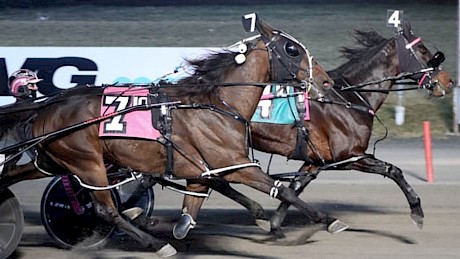 Lochinvar Art (Lauren Tritton) wins at The Meadowlands.Effect
Lochinvar Art (Lauren Tritton) wins at The Meadowlands.Effect
Few investigations have been done into just how much EIPH impacts on horses’ performances but one 2014 study on 744 thoroughbreds, reported in the Equine Veterinary Journal, concluded there was no association between EIPH grades 0, 1, 2 and 3 and long-term racing performance.
Blood in the airways and pulmonary tissue can cause inflammation but the animals recover relatively quickly.
Horses diagnosed with Grade 4 EIPH are, however, likely to have their career shortened, with permanent damage to the soft tissue of the lungs and reduced respiratory capacity.
High profile Australian pacer Lochinvar Art was reported to have had a Grade 4 bleed when finishing sixth to Copy That in the Gammalite Free-for-all at Melton last September and he has since been exported to the United States where he can race on Lasix to combat EIPH.
A diuretic called Furosemide, Lasix increases urine output and thus reduces blood volume and hence capillary blood pressure.
Lochinvar Art last week scored a brilliant 1:50.2 win on debut at The Meadowlands in New Jersey.
While Lasix can be given during training in New Zealand it must be out of the horse’s system come raceday. A number of legal medications are used to help reduce inflammation and bleeding.
FLAIR nasal strips are favoured by some, making it easier for horses to pull air through the nose during exercise.
More news in Harness
Ray doesn’t pull any punches about Sugar Ray but punters weigh in nonetheless
Partners and pedigree made Johnny Lincoln’s win special - but where was everyone?
Shunt and tangled tail hamper our Johnny - why he can win Friday’s Lincoln Farms Pace
Ray: Put the line through Johnny’s last run - it was a walk-fest and he copped it late
Our runners this week: How our trainers rate them

Ray’s comments
Thursday night at Cambridge
Race 7: Im Not The Maid
8.15pm
“She couldn’t knick off a perfect trip last time in the amateur race so I won’t be holding my breath here.”

Ray’s comments
Friday night at Auckland
Race 2: Leo Lincoln
5.53pm
“It looks like it will be a replica of his last two runs. He needs to drop down a class.”
Race 2: Kevin Kline
5.53pm
“I think he’lll go another good race but you couldn’t make a case for him to beat the two favourites (American Me or Mantra Blue). If he ran third, I’d be rapt. He’s very genuine and his form reflects that.”
Race 3: The Rascal
6.24pm
“We’ve chucked him in the deep end - he’s a maiden against race winners - but he’s improving all the time. Fergy had difficulty steering him last time and said if he could have got him out, he would have won. We’ve made little changes to his gear this time and I think he’s a serious contender.”
Race 7: Sugar Ray Lincoln
8.26pm
“He feels super in his work. I’m really pleased with him. I know he hasn’t lived up to his early promise but the way he’s training he might now be ready to realise it.”
Race 9: Dreams Of Eric
9.32pm
“He wasn’t handling the right-handed going so well, which was why he switched to racing at Cambridge, but he’s a genuine little guy, a strong colt with a bit of speed. I think he’s a chance, it’s just the draw, but it’s only a small field.”


